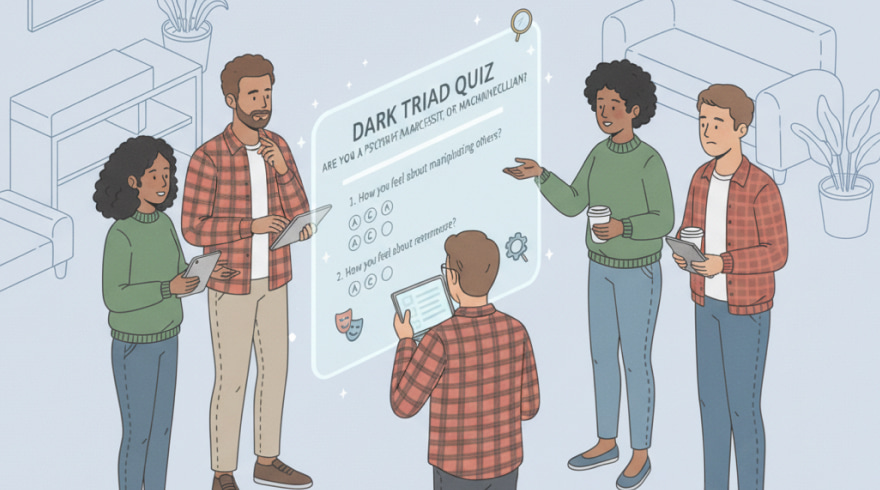Your Complete Guide to Assessing Dark Triad Traits Online
- 5 November 2025

Why Interest in These Assessments Keeps Growing
Curiosity about shadow-side traits has moved from academic journals into everyday conversations, and with good reason. People want sharper language for describing manipulation, entitlement, and callousness, not to stigmatize, but to recognize patterns and set healthier boundaries. Online assessments make that exploration accessible, offering structured prompts that surface motives and strategies you might otherwise miss. When crafted responsibly, these instruments help you translate fuzzy impressions into data points you can reflect on, compare over time, and discuss constructively with peers or coaches.
Beyond pure self-knowledge, there is a practical, preventive angle that resonates with professionals, students, and team leaders. In many popular assessments, the dark triad personality quiz provides a structured pathway to reflect on motives without pathologizing everyday competitiveness or ambition. Thoughtful feedback illuminates when charm turns into manipulation, or when assertiveness edges into exploitation. Measured properly, the results don’t label you; they highlight tendencies that become risky under stress, in high-conflict roles, or in incentive systems that reward short-term wins over long-term trust.
- Gain shared vocabulary for discussing difficult behaviors without blame.
- Spot early signs of toxic dynamics before they calcify into culture.
- Calibrate boundaries and expectations in partnerships and collaborations.
- Track changes over time as you practice new habits and coping strategies.
- Inform coaching plans with concrete, observable behaviors instead of guesswork.
What the Three Traits Measure and Why Nuance Matters
The triad typically includes Machiavellianism, Narcissism, and Psychopathy, each with distinct flavor. Machiavellianism revolves around strategic manipulation, instrumental charm, and a results-first calculus. Narcissism centers on status sensitivity, admiration seeking, and fragile self-esteem beneath a confident veneer. Psychopathy focuses on low empathy, impulsivity, and fearlessness, which can look like decisive boldness in some contexts and reckless disregard in others. These aren’t diagnoses; they’re personality patterns measured along continua with strengths and liabilities intertwined.
Because real lives are complex, high scores alone never tell the whole story. Alongside those dimensions, a well-designed dark personality quiz translates abstract descriptors into plain-language statements you can rate. Context then matters: environments that lionize extremes, hyper-competitive sales floors, high-volatility trading, ruthless politics, can amplify cutthroat tactics, whereas values-driven cultures tend to blunt them. Interpretation also benefits from triangulating with peers’ observations, past performance data, and stress indicators, so outlier scores don’t become myths you start believing about yourself.
- Machiavellianism: long game strategizing, selective disclosure, calculated reciprocity.
- Narcissism: status calibration, dominance signaling, vulnerability to ego threat.
- Psychopathy: reward focus, emotional detachment, thrill-seeking under pressure.
How the Assessment Works, How to Read Scores, and What to Expect
Most instruments present brief statements about everyday situations and ask how strongly you agree. Scoring aggregates responses into subscales, then normalizes them against comparison groups so you can see where you land. Good reports include explanations in plain language, real-world examples, and guidance that avoids sensational labels. Many people compare subscales with a psychopath personality quiz to understand affective coldness and impulsivity better. Still, the most helpful feedback focuses on behaviors you can adjust, like transparent communication, accountability rituals, and collaborative goal setting.
To make the mechanics tangible, the quick reference below maps typical statements to what they may suggest in practice. Use it as a reading aid rather than a verdict; the why behind your responses matters as much as the numbers.
| Trait Focus | Sample Statement | Possible Behavior Signal | Suggested Guardrail |
|---|---|---|---|
| Machiavellianism | I prefer to keep plans to myself until I gain advantage. | Information hoarding and transactional alliances. | Adopt default transparency and document decisions. |
| Narcissism | I feel I deserve special recognition for my contributions. | Status monitoring and sensitivity to perceived slights. | Share credit publicly and request candid peer feedback. |
| Psychopathy | I rarely feel anxious, even when risks are high. | Bold action without adequate contingency planning. | Use premortems and external risk reviews before launch. |
- Prefer assessments with reliability data (e.g., internal consistency) and clear norms.
- Look for behaviorally specific recommendations rather than generic labels.
- Re-take on a consistent schedule to observe trends, not isolated spikes.
- Invite a trusted colleague to comment on how results show up at work.
Concrete Benefits for Individuals, Teams, and Leaders
When used thoughtfully, these assessments transform awkward conversations into constructive dialogue. Individuals gain sharper self-awareness about the tradeoffs in their default strategies, especially under deadline stress or social threat. Teams become better at naming dynamics that sap trust, like strategic ambiguity, credit grabbing, or risk dumping. Leaders learn to match guardrails to contexts, tightening controls in high-conflict roles while preserving autonomy where creativity thrives. Over time, small adjustments, clearer expectations, shared checklists, decision logs, compound into safer, more effective collaboration.
The same tools can support coaching, hiring, and conflict resolution when paired with transparent ethics. For leaders, a concise narcissist personality quiz can spark coaching conversations about status sensitivity and recognition needs. Recruiters might employ trait-informed interview prompts that test follow-through, empathy, and accountability without venturing into diagnosis. Mediators can map conflict patterns to misaligned incentives rather than villainizing people. Across these scenarios, the win is a culture that rewards long-term reciprocity over short-term advantage seeking.
- Coaching: turn abstract scores into weekly behavior experiments with metrics.
- Hiring: focus on job-relevant behaviors and structured work samples.
- Conflict: separate intention from impact and agree on explicit norms.
- Leadership: align risk appetite with guardrails and independent review.
Interpreting Results Responsibly and Recognizing Limits
Scores are signals, not verdicts. Context, incentives, and stress load can magnify or mute traits dramatically, so it’s crucial to examine situations where tendencies appear. High competitiveness can look heroic in a turnaround and hazardous in a compliance role. Low anxiety can produce cool-headed crisis management or reckless shortcuts, depending on oversight and culture. The real power of these tools lies in pairing self-reflection with environmental design, change the conditions, and behavior changes too.
If you have clinical worries, a formal antisocial personality disorder quiz belongs in a healthcare context rather than a hobbyist forum. Online trait measures are not diagnostic instruments and should never replace a clinician’s evaluation. Ethical use means informed consent, privacy safeguards, clear disclaimers, and a strict boundary against medical claims. If results feel alarming, consider them an invitation to speak with a licensed professional who can assess history, functioning, and risk with validated methods and an individualized plan.
- Never use results to stigmatize, threaten, or retaliate against others.
- Protect data with encryption, limited access, and defined retention windows.
- Favor plain-language feedback over sensational interpretations.
- Consult trained professionals when safety or clinical risk is in question.
How to Choose a Trustworthy Assessment and What to Do Next
Not all tests are created equal, so treat selection like any important purchase. Credible creators publish methodology, reliability coefficients, and the make-up of their norm groups. Item wording should be specific and balanced, not leading or theatrical. Reports ought to include behaviorally anchored suggestions and references, not vague horoscopes. Most importantly, the platform should handle your information with sensible security, data minimization, and transparent deletion policies that you control.
When browsing options, an evidence-informed antisocial personality quiz will explain how items were validated and how scale reliability was calculated. Look for guidance on re-testing intervals, context considerations (e.g., work vs. personal life), and ways to combine self-ratings with 360 feedback. After you choose, schedule a quiet time, answer honestly, and capture a few concrete commitments based on your report. Then translate those into daily habits, calendar reminders, peer check-ins, and review cadences, so insights become visible actions and measurable improvements.
- Documentation: seek a technical manual and a user guide in plain language.
- Privacy: confirm opt-outs, anonymization, and export/delete options.
- Support: favor tools that include coaching frameworks and conversation guides.
- Follow-through: convert findings into a 30-day behavior experiment with metrics.
FAQ
Are these assessments the same as clinical diagnoses?
No. They measure personality tendencies on continua for self-reflection and development, not medical conditions. Only licensed clinicians can diagnose, and they use interviews, history, and validated tools in a comprehensive evaluation.
Can high scores ever be useful in the workplace?
Traits linked to boldness, confidence, and strategic thinking can help in crisis or negotiation, provided strong guardrails exist. The key is channeling strengths while mitigating risks through transparency, accountability, and independent review.
How often should I retake an assessment?
Every three to six months is reasonable for tracking change, as long as your environment and stress levels have not radically shifted. Keep conditions consistent across retakes to make trends meaningful rather than noise.
What if my results conflict with how others see me?
Use the gap as a coaching prompt. Invite concrete examples from colleagues, compare contexts, and look for situations where your intent and impact diverge. Then design small experiments to test new behaviors and revisit feedback.
How can teams discuss results without creating stigma?
Establish norms first: voluntary sharing, no labeling, and a focus on observable behaviors. Frame the conversation around collaboration, guardrails, and goals, and end with clear agreements about how the team will support change.
Latest News
-
![Comprehensive Guide to Sociopathy Self-Assessments and Quizzes]()
- 10 November, 2025
-
![A Complete Guide to Understanding the Dark Triad Quiz]()
- 7 November, 2025
-
![The Guide to Narcissism Self-Assessments: Insights, Benefits, and Smart Next Steps]()
- 6 November, 2025



